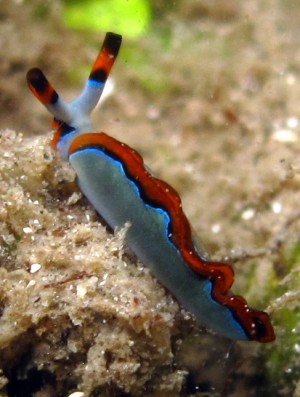
Thuridilla coerulea
(Kelaart, 1858)
Order: SACOGLOSSA
Family: Elysiidae
PHOTO
Locality: Near by Wandoor, 0.3 metres, Andaman & Nicobar, India, Andaman Sea, 8 March 2010, Intertidal, some Dead coral rocks beneath sediment. Length: 12-18 mm. Photographer: Vishal Bhave.
Thuridilla coerulea is blue with red-orange and black markings. The oral tentacles are orange red with a black edging and the upper half of the rhinophores are black with a central black band. The parapodia are blue with a broad red-orange margin and an inner thin black line.
As two similarly coloured species have subsequently been described [T. lineolata and T. undula] and as T. coerulea has not been reported since its original description it is appropriate to clarify its identity. Like many of Kelaart's description, it is brief but the accompanying illustration clearly show the colour pattern.
"This is a very small, beautiful species, about 3/4 inch long; when the wings are folded, it is not thicker than a crow's quill. Tentacles 2; blue with a central red ring, tip blackish. Body and wings blie; under part of head, and fore part of foot, red; edge of wing lines with black and red lines, the latter outermost."
Eliot (1906) reviewed Kelaart's specimens and drawings and noted that T. coerulea "can hardly be anything but Elysia lineolata of Bergh, which has a similarly gorgeous coloration, though there are some differences in detail. For instance, in Kelaart's animal the rhinophores have not red tips, but a red ring below a black tip." In Gosliner's (1995) review of Thuridilla, he tentatively kept the two species separate pending the rediscovery of animals fitting Kelaart's description.
If it were just the black tips to the rhinophores which separated T. coerulea and T. lineolata then I would agree with Eliot, but both Eliot and Gosliner have apparently missed the broad red-orange band running along the base of the parapodia in T. lineolata which is absent in Kelaart's original drawing and in Vishal Bhave's photo which accompanies this Fact Sheet.
Interestingly, Thuridilla coerulea is almost identical in colour to Gosliner's T. undula, differing in two details of the colour pattern. As its name suggests, the orange parapodial border in T. undula undulates with deep incursions into the blue part of the parapodia, while in T. coerulea the orange band is almost straight. The only other difference between these two species appears to be that the tips of the rhinophores are black in T. coerulea, while in T. undula this black tip is absent.
It is possible that T. undula, rather than T. lineolata, is a synonym of the earlier T. coerulea but we need to know more about the variability found in both 'species'.
- Eliot, C.N.E. (1906) On the nudibranchs of Southern India and Ceylon, with special reference to the drawings by Kelaart and the collections belonging to Alder & Hancock preserved in the Hancock Museum at Newcastle-on-Tyne. Proceedings of the Zoological Society of London, [for 1906] 2: 636-691. (Pls. 42-47). [Plate XLIII. Fig. 7 Elysia coerulea]
- Gosliner, T.M. (1995) The genus Thuridilla (Opisthobranchia: Elysiidae) from the tropical Indo-Pacific, with a revision of their phylogeny and systematics of the Elysiidae. Proceedings of the California Academy of Sciences, 49(1): 1-54.
- Kelaart, E.F. (1858). Description of new and little known species of Ceylon nudibranchiate molluscs and zoophytes. Journal of the Ceylon Branch of the Royal Asiatic Society, Colombo, 3(1): 84-139.with 2 plates
Rudman, W.B., 2010 (April 13) Thuridilla coerulea (Kelaart, 1858). [In] Sea Slug Forum. Australian Museum, Sydney. Available from http://www.seaslugforum.net/find/thurcoer
Related messages
Re: Rediscovery of Kelaart's Thuridilla coerulea from Andaman and Nicobar Islands
April 29, 2010
From: Vishal Bhave
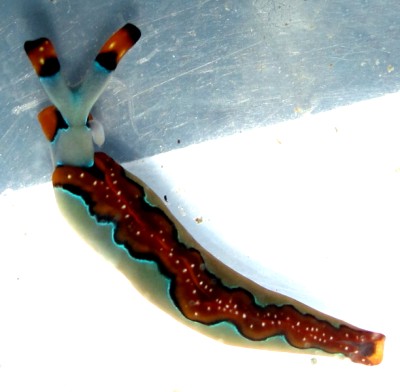
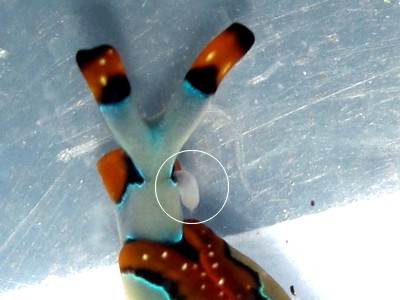
Concerning message #23404:
Dear Bill,
As per mentioned in earlier message we got two similarly looking (in Field) species one with white specks and other without.
Locality: Port Blair, 0.5 metres, Andaman & Nicobar islands, Andaman Sea, 7 March 2010, Intertidal muddy-rocky shore with scattered Halimeda and Sea grass patches. . Length: 20 mm. Photographer: Vishal Bhave.
Thank you.
Vishal Bhave
vishalbhave@gmail.com
Bhave, V.J, 2010 (Apr 29) Re: Rediscovery of Kelaart's Thuridilla coerulea from Andaman and Nicobar Islands. [Message in] Sea Slug Forum. Australian Museum, Sydney. Available from http://www.seaslugforum.net/find/23580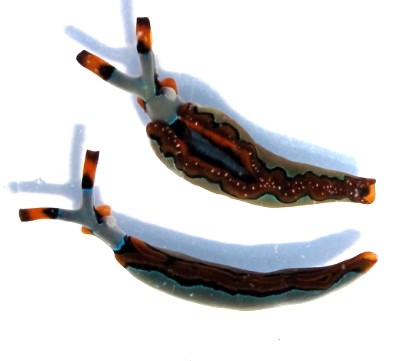
Dear Vishal,
These photos are particularly interesting because they suggest to me that T. moebii and T. undula are just extreme colour forms of the much older T. coerulea.
Sreeraj's message [#23355] shows a rather typical specimen of T. moebii, with a white-spotted brownish orange border to the parapodia. I have already discussed [message #23404] the similarities between T. coerulea, and T. undula.
Your photos here show what looks to me to be an intermediate between T. coerulea and T. moebii. The biggest problem with all these names is that we have so few records of these species that we have little knowledge of colour variability. Your messages, and Sreeraj's, from the Andaman & Nicobar Islands suggests you may be sampling a population of one species with a variable colour pattern. If this proves to be true, the oldest name would be T. coerulea.
As I discuss on the T. coerulea Fact Sheet, another similarly coloured species, T. lineolata, differs in having an orange band along the base of each parapodia.
In the close-up I have ringed the everted penis.
Best wishes,
Bill Rudman
Rediscovery of Kelaart's Thuridilla coerulea from Andaman and Nicobar Islands
April 14, 2010
From: Vishal Bhave
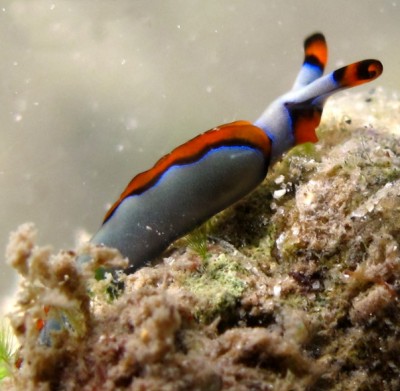
Concerning message #23355:
Dear Bill,
We were their in Andamans too with Sreeraj when he found Thuridilla moebii. Though his message is about slug from the island of Nicobar we got a similar looking species in the Andamans too, one with the spots on brownish parapodial margin and another without those spots.
One other species which has very similar external characters is Thuridilla coerulea (Kelaart 1858). Eliot in his 1906 publication stated that it
"can hardly be anything but Elysia lineolata of Bergh, which has a similarly gorgeous coloration, though there are some differences in detail. For instance, in Kelaart's animal the rhinophores have not red tips, but a red ring below a black tip."
I got this information from Gosliner (1995).
Locality: Near by Wandoor, 0.3 metres, Andaman & Nicobar, India, Andaman Sea, 8 March 2010, Intertidal, some Dead coral rocks beneath sediment. Length: 12-18 mm. Photographer: Vishal Bhave.
- Gosliner, T.M. (1995) The genus Thuridilla (Opisthobranchia: Elysiidae) from the tropical Indo-Pacific, with a revision of their phylogeny and systematics of the Elysiidae. Proceedings of the California Academy of Sciences, 49(1): 1-54.
Vishal Bhave.
vishalbhave@gmail.com
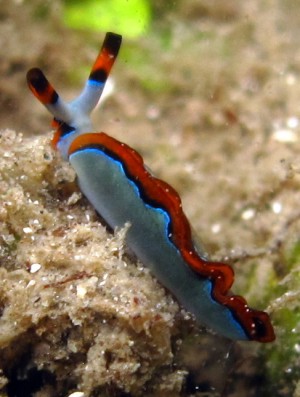
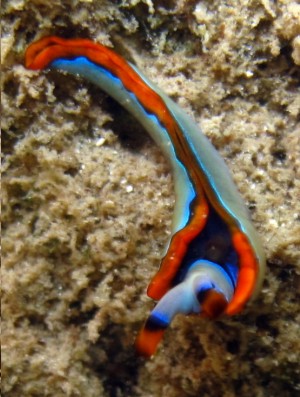
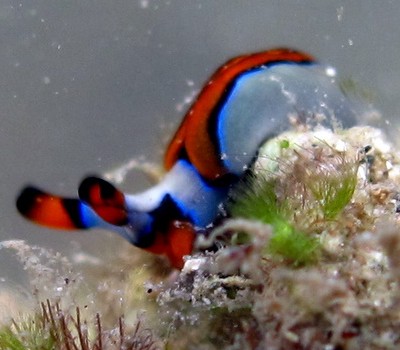
Dear Vishal,
This is an interesting find, and as you say it matches Kelaart's Elysia coerulea very well. It is certainly similar to T. lineolata but one major difference is that in that species there is a black and orange band along the base of each parapodia which is absent in Kelaart's illustration of T. coerulea and in your animals as well. Thuridilla coerulea is almost identical to the species that Gosliner has named T. undula, differing in two details of the colour pattern. As its name suggests, the orange parapodial border in T. undula undulates with deep incursions into the blue part of the parapodia, while in your T. coerulea the orange band is almost straight. The only other difference appears to be that the tips of the rhinophores are black in T. coerulea, as described by Kelaart, while in T. undula this black tip is absent.
It is possible that T. undula, rather than T. lineolata, is a synonym of the earlier T. coerulea but I guess we should wait until we know more about the variability found in both 'species'.
Best wishes,
Bill Rudman
